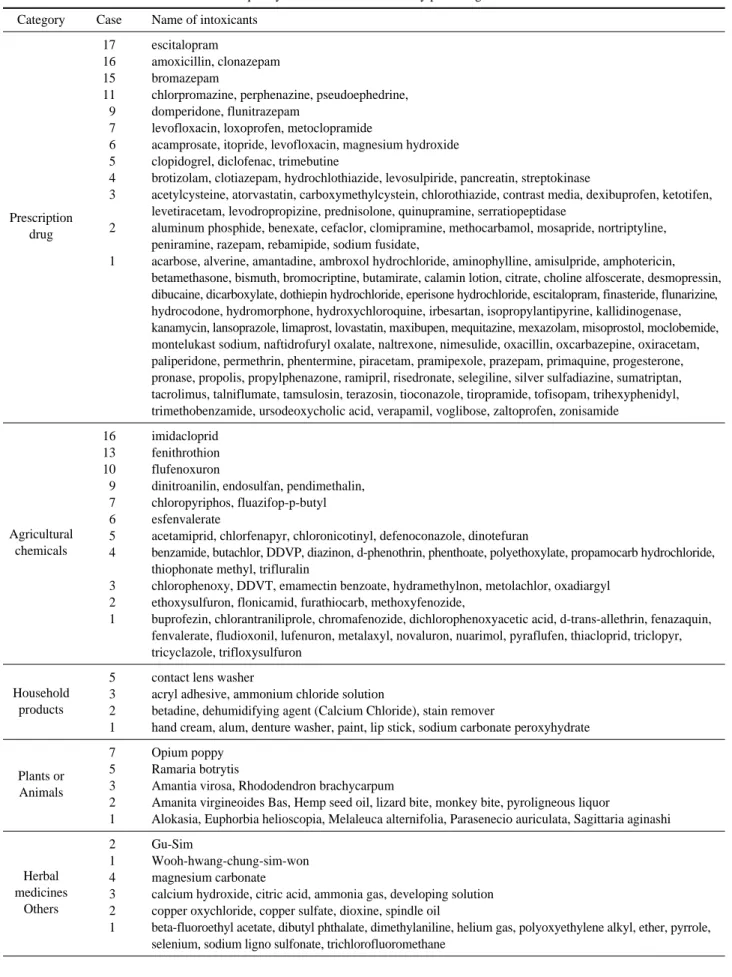원 원 저저
of Clinical Toxicology
Tox-Info 시스템의 중독정보 데이터베이스와 응급실에 내원하는 중독 환자 분포의 비교
연세대학교 의과대학 응급의학교실, 인제대학교 의과대학 응급의학교실1, 연세대학교 원주의과대학 응급의학교실2, 서울대학교 의과대학 응급의학교실3, 가톨릭대학교 의과대학 응급의학교실4, 건국대학교 의학전문대학원 응급의학교실5,
경상대학교 의과대학 응급의학교실6, 대구가톨릭대학교 의과대학 응급의학교실7, 고려대학교 의과대학 응급의학교실8, 을지대학교 의학과 응급의학교실9, 한림대학교 의과대학 응급의학교실10, 인제의대 해운대백병원 응급의학과11
김현종∙김양원
1∙김@ 현
2∙박창배
3∙소병학
4∙이경룡
5∙이경우
6이경원
7∙이성우
8∙이장영
9∙조규종
10∙조준호
11∙정성필
Comparison between Emergency Patient Poisoning Cases and the Tox-Info System Database
Hyun Jong Kim, M.D., Yang Weon Kim, M.D.
1, Hyun Kim, M.D.
2, Chang Bae Park, M.D.
3, Byung Hak So, M.D.
4, Kyeong Ryong Lee, M.D.
5, Kyung Woo Lee, M.D.
6, Kyung Won Lee, M.D.
7,
Sung Woo Lee, M.D.
8, Jang Young Lee, M.D.
9, Gyu Chong Cho, M.D.
10, Junho Cho, M.D.
11, Sung Phil Chung, M.D.
Department of Emergency Medicine, Yonsei University College of Medicine, Seoul, Department of Emergency Medicine, Inje University College of Medicine, Busan
1Department of Emergency Medicine, Wonju College of Medicine, Yonsei University, Wonju
2Department of Emergency Medicine, College of Medicine, Seoul National University, Seoul
3Department of Emergency Medicine, College of Medicine, The Catholic University of Korea
4Department of Emergency Medicine, School of Medicine, Konkuk University, Seoul
5Department of Emergency Medicine, School of Medicine, Gyeongsang National University
6, Department of Emergency Medicine, College of Medicine, The Catholic University of Daegu
7,
Department of Emergency Medicine, Korea University College of Medicine, Seoul
8, Department of Emergency Medicine, College of Medicine, Eulji University, Deajeon
9, Department of Emergency Medicine, College of Medicine, Hallym University, Seoul
10, Department of Emergency Medicine, Inje University, Haeundae Paik Hospital, Busan, Korea
11Purpose: The Tox-Info system is a poisonous substance information database developed by the Korean National Institute of Food and Drug Safety Evaluation. The aim of this study was to estimate the coverage effectiveness of the Tox-Info system by comparing the toxic substances included in the database with the distribution of the toxic substances implicated in the cases of intoxicated patients presenting to emergency departments. The secondary aim of the study was to propose any additional substances that should be added to the database.
투고일: 2012년 3월 27일 게재승인일: 2012년 4월 24일 책임저자: 정 성 필

